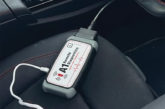Garage management system developer, TechMan, shares a typical investment dilemma.
“David owns a successful garage with 6 ramps and 5 technicians,” said Leo Freebairn, TechMan’s National Sales Manager. “Last week he spent £18,000 on the latest diagnostic kit for his garage.
“He made that decision in one day but he’s been considering implementing a new garage management system for over two years.
“He told me ‘I can’t figure out if I’m wasting my money’.”
David knows he can put the new diagnostic machine in the garage and earn money right away but doesn’t see the case for the management system as clearly.
TechMan say this is not unusual; for any business-focused garage owner willing to invest, juggling competing priorities usually boils down to one simple thing – ‘return on investment’.
Any garage management system is simply a database at its core. All prospect or customer interaction should be stored within it. This data can then be used both to make working with customers more efficient and to maximise the opportunities with prospects.
A good garage management system will make previously complex jobs like searching customer histories or sending reminders incredibly simple. It should not only link to your accounting system but also to all your customer contact history for a single-point view.
Calculating the financial benefit of all this does require a bit of thought. TechMan suggest garages looks at three basic areas over the last one, or ideally two years.
First…
Consider approximately how many winnable jobs were lost, simply because quotations weren’t sent, tracked or followed up properly.
Once you have that number, you’ll need to multiply it by your average job invoice value, and then by your percentage profit margin to see ‘lost profit from quotations’.
Second…
Look at the time that gets wasted performing manual tasks. This could be sorting spreadsheets, sifting data, looking through job histories, sending reminders or rekeying paper notes into the computer.
Approximate the number of hours and then multiply that by an average hourly staff wage to find the cost of your unproductive time. Assume your management system can cut this by 50% to get to the ‘wasted cost of manual processes’.
Third…
Look at work retention for existing customers. Try to establish how many customers miss appointments and don’t rebook, or don’t return for the next MOT or service.
Assume your management system can capture 25% of this lost work through better communication.
Again, multiply that number by invoice value then profit margin in the same way to define ‘lost profit from customers’.
Finally, add up the three figures and compare them to the monthly cost of the management system.
“It takes a bit of time to paint this picture,” said Leo. “But we’ve never yet quoted a prospect where there isn’t a return on investment and we’ve never had a customer that didn’t find the real return exceeded this budget figure.”










